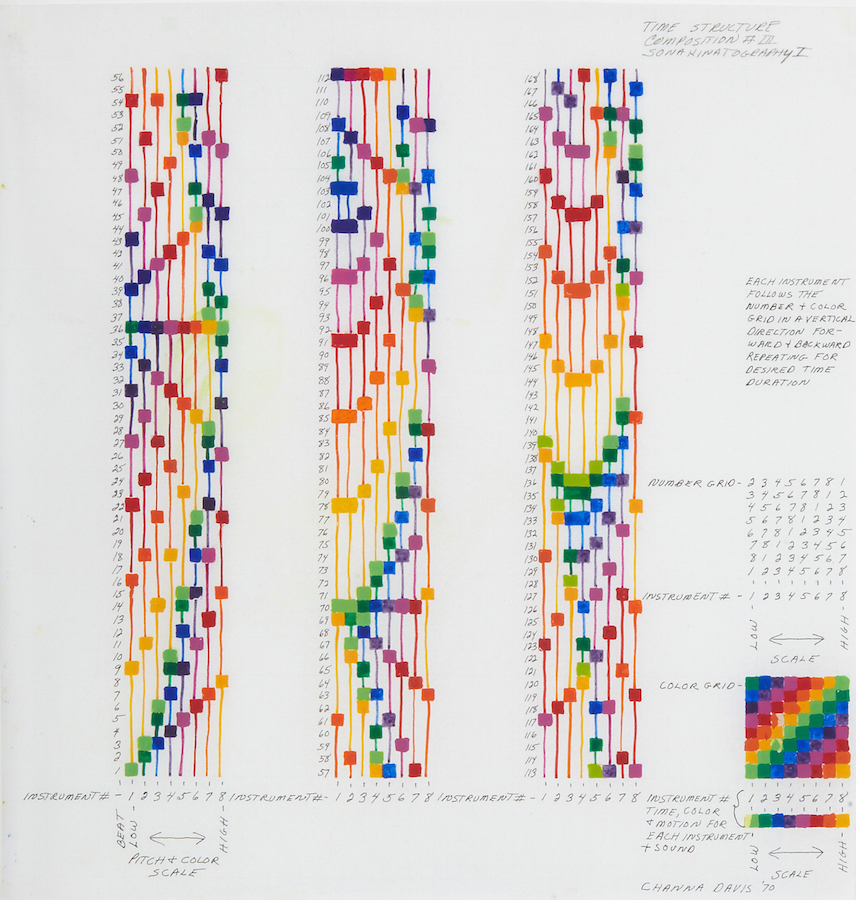


Channa Horwitz , 'Time Structure Composition III, Sonakinatography I', 1970, Casein paint on graph paper. Courtesy Estate of Channa Horwitz. Photo by Timo Ohler
The quiet, white spaces at Raven Row seem perfectly suited to the work of Channa Horwitz. Focusing principally on her Sonakinatography and Language series, sound and movement are mutely invoked through her meticulous notations. The domestic scale of the interconnecting upper rooms particularly favours the consideration of paintings that are intimate in size and exact close examination from the viewer. Generally painted in the highly controllable casein paint on polythene film known as Mylar, Horwitz’ intricate geometric patterns can resemble musical scores, or designs for weaving.
This first-ever large scale presentation of Horwitz’ work in the UK is the second iteration of a show initiated last year at the KW Institute for Contemporary Art in Berlin. For anyone who may have come across her work for the first time at the 2013 Venice Biennale, or last year at the Tinguely Museum in Basel as part of Haroon Mirza’s collaborative exhibition, this is at last an opportunity to grasp Horowitz’ project in greater depth. Massimiliano Gioni’s unifying concept of the Encyclopaedic Palace for Venice brought together artists with unique ‘personal cosmologies’ – and incidentally also presented Hilma af Klint, currently subject of a solo presentation at the Serpentine Gallery. In Basel, Haroon Mirza’s transcription of Horowitz’Sonakinatography notations into a sound and light, was one of the highlights of that show. During her lifetime, Horwitz actively encouraged younger artists to make musical interpretations of her work.
Both shows offered a tantalising glimpse of an artist whose work was little known in her native California during her lifetime, let alone internationally. At the time of her death in 2013, in her early 80s, Channa Horwitz was just beginning to gain the recognition that she merited. In spite of working in relative obscurity for decades, Horwitz’ assiduous pursuit of her self-defined project is amply demonstrated in the current exhibition.
Horwitz first went to art school in Pasadena in 1950 then, after starting a family, to California State University in 1960, returning to study at CalArts in 1972. Colleagues in this last institution included James Turrell and Sol LeWitt , and while it is useful to note this in setting some points of orientation for her career, Horwitz developed in comparative isolation by comparison to these highly successful male artists, and should not be understood as purely conceptual or minimalist. She quickly developed away from figurative painting and evolved her own, tightly conceptualised system for making work from the early 1960s onwards. Feeling that real freedom was to be attained through strict adherence to a narrow range of self-imposed rules, she first reduced her formal vocabulary to the circle and the square, and then for theSonakinatography series to a scale of 1-8. The later Moiré and Canon series works that are shown in the upper galleries at Raven Row are densely patterned, luminously colourful paintings that have an exuberant playfulness that belies the meticulous control of their conception and making.
Caroline Douglas
Director
Channa Horwitz, Raven Row, 56 Artillery Lane, London E1 7LS. Open Wednesday to Sunday, 11.00 – 18.00. Exhibition continues until 1 May 2016. www.ravenrow.org